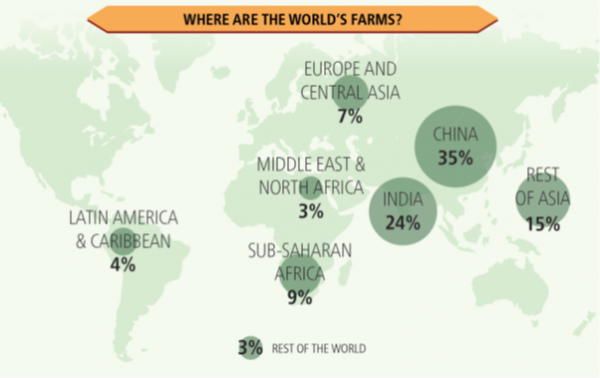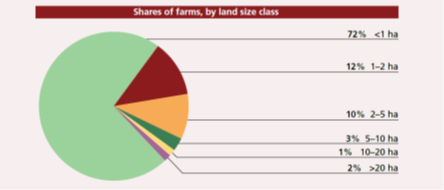Global food security/GFS101/Exploring the Global Food System/Different types of farms and actors within the global food system
Did you know that:
- 75% of the world food production is derived from just 12 plants and 5 animal species
- Small farms less than 10 hectares comprise 80 % of farmland and provide up to 80 % of the food supply in sub- Sharan Africa and Asia
- Women comprise 43% of the agricultural labor force in developing countries
Source: FAO 2012, Smallholders and Family Farmers Factsheet, viewed 29/01/2019,
- Across the world, 9 out of 10 farms (that’s over 500 million farms) are managed by families producing 80% of the world's food and occupy 70-80% of farmland.
Source: FAO 2014, Family Farmers Feeding the World, caring for the Earth, viewed 29/01/2019.
While 80 percent of all farms at a global level are less than 2 hectares they only cover 12 % of all farmland. This is in stark comparison to farms greater than 50 hectares, which cover two-thirds of all farmland and represent only 1 percent of all farms In low and lower-middle-income countries farms less than 50 hectares dominate agricultural land whereas in upper middle and higher - income countries large farms greater than 50 hectares are the norm.
Source: FAO 2014, The State of Food and Agriculture, viewed 29/01/2019.
***** ADD IN SOME ECOLOGICAL IMPACTS (Resource peaks) and info on urbanisation taking land, farmer moving to the city etc AND PERHAPS GROUP AND THEN GIVE SUB-HEADINGS TO FACTS) also still need to find open source acount of percentage of all food exported for trade versus consumed within countries. ***** In the World Resources Institute 2018 publication ‘World Resources Report: Creating a Sustainable Food Future' it is highlighted that relative to 2010 levels, a global population of 9.8 billion people in 2050 (with population increases predominantly in developing countries) will require a 56% increase to available global food calories. Also outlined is that:
- Assuming past rates of growth in yield production, relative to 2010 by 2050 an additional area twice the size of India will be needed placing pressure on the world remaining forests and biodiversity
- Estimating likely greenhouse emission from agricultural and land use change in 2050, the global agricultural sector will have to come up with a strategy to reduce annual greenhouse gas emission by 11 Gt CO2-e if it is to play a proportional role in keeping global warming to globally agreed targets.
- Farming cattle, sheep and goat contributes to half of the greenhouse gas emissions from the global agricultural sector and takes up to 2/3rd of worlds agricultural land. Demand for cattle, sheep and goat meat is expected to grow by 88 percent between 2010 to 2050 in concert with rising incomes.
- A fourfold increase in biofuel production from crops between 2010 to 2050 would imply a 76% increase to available global food calories.
The role of the global food system in meeting the challenges outlined above will be paramount.
So who are some of the key actors within the global food system?
First of all, there are key players who provide international policy guidance such as the Food and Agricultural Organisation of the United Nations, World Trade Organisation, and the many different institutions researching food technologies, practices, and nutrition. Then there are different countries who manage their food supply and agricultural lands on their own terms and incentivise their food production systems in different ways through subsidies, tariff arrangement, road and transport infrastructure, and land use planning and environmental protection policies. Another feature of the global food production system is that while there are many millions of producers (most of which operate on small family farms) and many billions of consumers there are a relatively small number of large transnational corporations involved across the supply chain. The latter supply agricultural fertilisers, chemicals, machinery and seeds, process, manufacture and package food, transport food from producer to global food markets, and then sell food into local retail markets. Atop of this, there are ancillary services providers such as petrochemical industries who provide fuels used in transport, agricultural machinery and the production of agricultural fertilisers, through to credit financiers and insurers, food marketing organisations, food aid organisations and many non-profit originations and community groups which fight for food justice.
In the next lecture, rich outlines some of the complexity of the global food system, the different scales in which food is grown and introduces you to some of its politics. This complexity challenges the notion that it is, in fact, one system, and perhaps is best characterised as a complex array of many interdependent social, cultural, environmental and economic systems.
Topic: Different types of farms and actors within the global food production system.
****REPLACE VIDEO CONTENT - XBR103Week1Video2EDITED*****
If you want to find out a little more about polyculture mixed farming we suggest you view the 2014 ABC Landline Interview with Joel Salatin. Made famous by internationally renowned academic, author, journalist and sustainable foods activist, Michael Pollan, Joel is one of US's most famous farmers and is a strong advocate for polyculture mixed farms. As part of his Australian Tour in this interview, Joel discusses his views on industrial agriculture and how he, in comparison, runs his farm.
After watching Rich's Week 2 lectures reflect on the following questions:
1. How could our global food system be managed for the betterment of all people, farmers, and the ecosystems which support it?
2. How do you think food production could be improved to ensure we can feed everyone sustainably in 2050?
Please direct your self to the Discussion Board titled: Activity 4: Global Food System so that other students can engage with your response. Feel free to comment on other posts as it will help you with your own thinking.
Case Studies help observe theory in practice. In the next lecture, Alistair focuses on the agricultural production systems within Tasmania. Specifically, he focuses on:
1. its context,
2. examples of animal and plant industries in Tasmania,
3. key features of what makes Tasmania competitive, and
4. his reflections into modern farming practices of Tasmania vs smallholder operations in Sri Lanka.
****REPLACE VIDEO CONTENT - XBR103Week1Video1EDITED*****
The previous lecture sparks a short discussion between Rich, Aidan and Alistair on the role of science and technology within the agricultural system. Have a listen to the audio lecture below.
Topic: Rich, Aidan and Alistair’s reflection on the role of science and Technology with the global food production system.
For further information on the Tasmanian government response to food security, case studies of how Tasmanian are helping to secure food in their community, and related resources please follow the following links:
Tasmanian Department of Health and Human Services, Food Security Webpage.
Healthy Food Access Tasmania Webpage
The following video is a lecture by Michael Pollan presented at the University of Calfornia (UC) Davis Mondavi Center. Michael Pollan is an author and academic and in this lecture he speaks on his book The Omnivore's Dilemma: A Natural History of Four Meals. He explores the ecology of eating and why we consume what we consume in the twenty-first century.}
FAO/IFAD/UNICEF/WFP/WHO, 2017: The State of Food Security and Nutrition in the World 2017. Building Resilience for Peace and Food Security. Food and Agriculture Organisation of the United Nations, Rome, vi.



